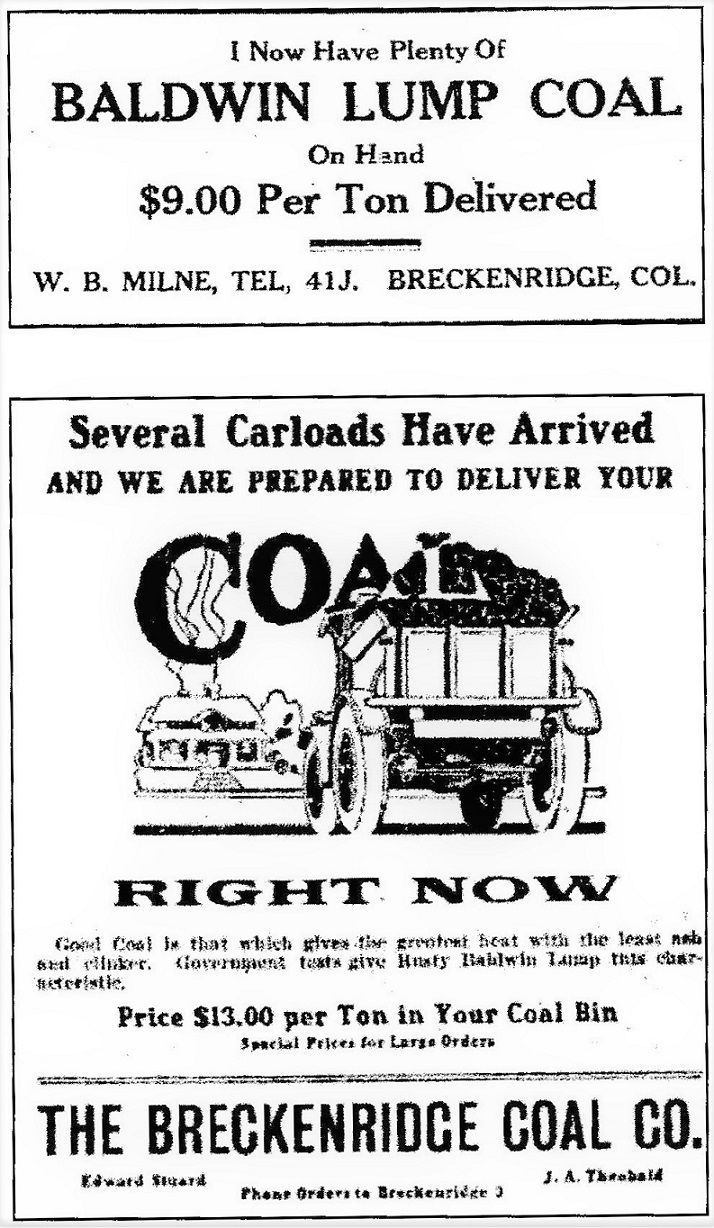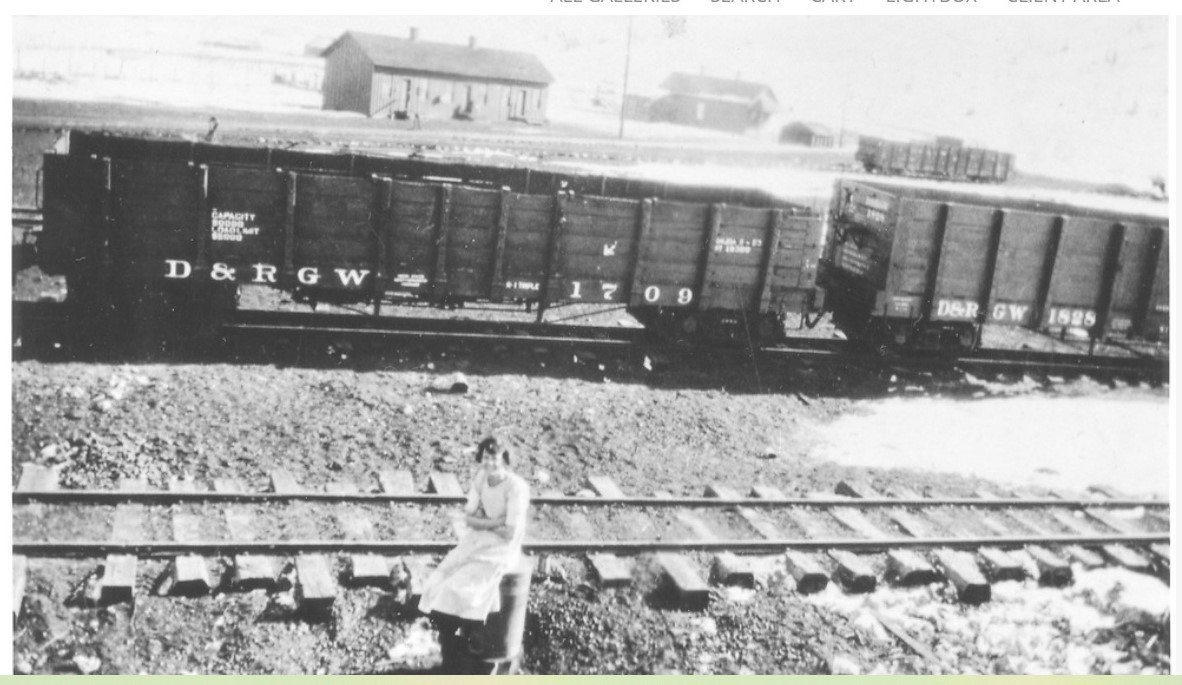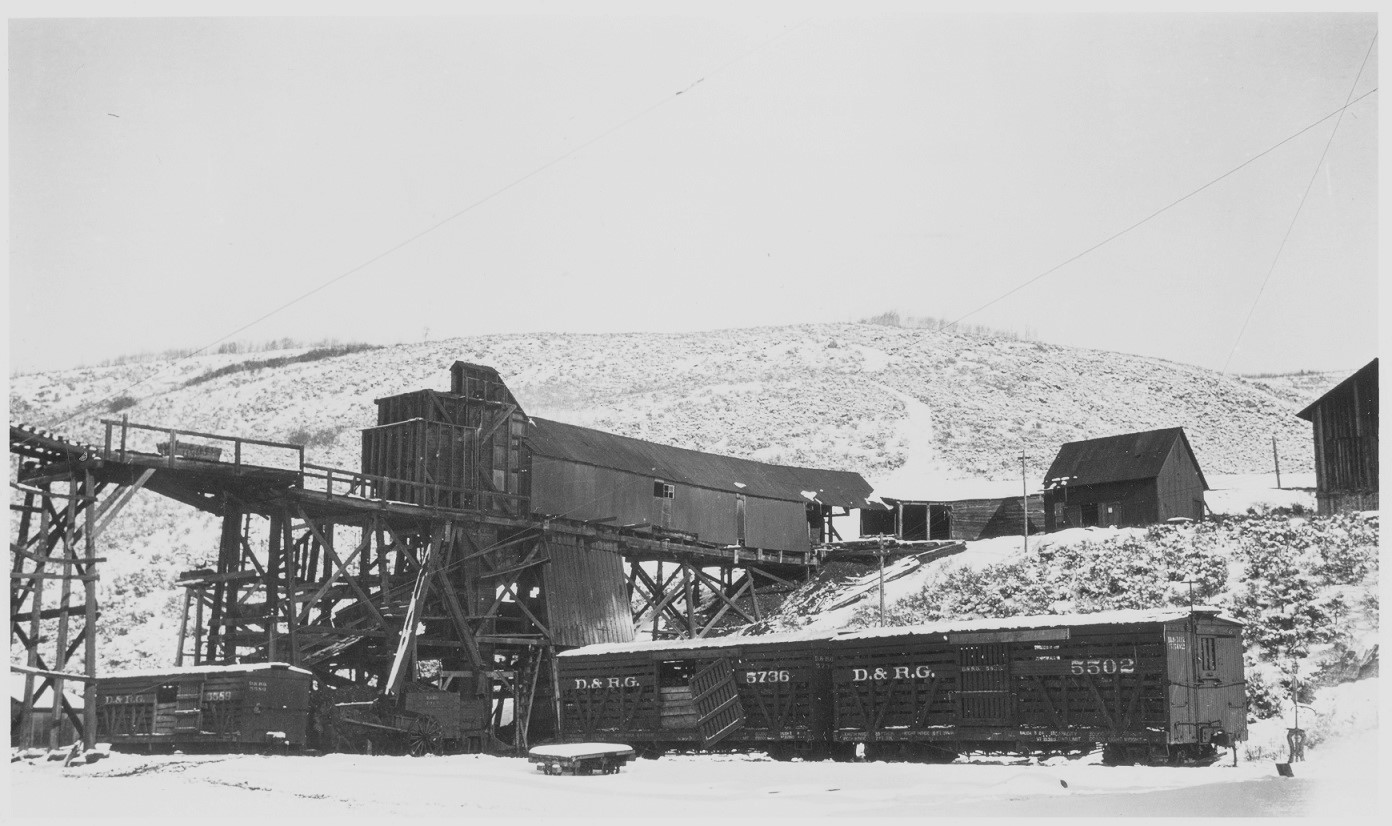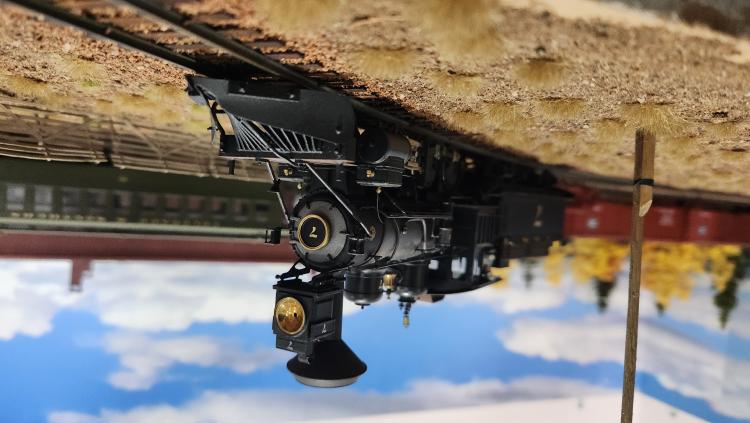C&S Coal Usage on the C&S ng
|
Administrator
|
Keith and I were discussing coal usage on the West End on Saturday. I've worked up some data that you may find interesting.
All of the coal for railroad use came up from Denver to feed the Docks at Pine Grove, Como, Dickey, and Leadville. As noted previously, the coal originated mostly from either Trinidad or the much more desirable Oak Creek, near Steamboat. First, let's look at the load capacity of the Coal Cars. Translating to tons is relevant for a number of reasons. Capacity 50,000 lbs. which translates to 25 tons. Loaded Capacity is listed as 55,000 lbs, which translates roughly to 27 tons. Empty Weight is listed at 19,000 lbs, or roughly 10 tons. Subtracting empty weight at 10 tons from "Capacity" at 25 tons means that the actual tonnage per load of coal is about 15 tons. Following is the capacity of coal per tender of various classes. B-3-C, B-4-C is 5 tons. B-4-D, B-4-E is 6 tons. B-4-F is 8 tons. We know that the number of engines on each freight train, as low as two per train to four per train over the six day operation runs from 12 engines to 24 engines for freight locomotives per week. Add to this 6 more engines per week for the passenger train and the totals range from 18 to 30 engines each week. If we are to assume that the average fill for the engines is 5 tons per engine, the number of tons of coal would range from 90 tons to 150 tons per week. 90 tons, which would be minimum, at 15 tons per car is 6 loads of coal. 150 Tons, which would be at the high end, at 15 tons per car is 10 loads of coal. These numbers are for each coal dock. So the number of loads leaving Denver each week would be 24 to 40 loads a week. The number of loads from Como to Leadville would be half that, 12 to 20 loads per week. Each of the four Coal Docks would use two to three and a half loads per day. Keith thought that one of the multiple engine trains carried one engine just for coal. That's probably right on the West End, but it would be twice that on the East End. I suspect in later years, coal probably made up most of the tonnage on Westbound trains, as there probably wasn't a lot of revenue freight Westbound. Empty cars only made up half the tonnage of loaded cars. These figures may be heavier than is realistic, especially since the helpers ran light downgrade and probably need didn't need 5 tons. Food for thought, though. Keith is right, the C&S spent a lot of money hauling their own coal. |
|
Mile
Tare weight of a car does not figure in its capacity. If the marked capacity is 50,000, the car can be safely loaded to 50,000 pounds with a gross weight of 70,000 pounds. The load limit of 55,000 pounds allows for some overage as these cars were't loaded on a scale. On my Marshall Pass data weights are given as gross (10 tons for the car) and very, very few were as high as 38 tons with the vast majority between 34 and 36 tons for a 50,000 pound capacity car. Remember the shipper was likely filling orders for 25 tons, so anything above was lost revenue/ Pat |
Re: C&S Coal Usage on the C&S ng
|
In reply to this post by Mike Trent
Mike, this data is for the C&S narrow gauge after 1910, correct?
I believe prior to that date Baldwin coal was still extensively shipped both to consignees of, and for use by, the narrow gauge, to the extent that if early winter's first seasonal tunnel blockades stranded cars of Baldwin coal in Gunnison or Baldwin the cars were moved over Marshall Pass, in D&RG trains in C&S cars. Or was the Baldwin traffic winding down prior to 1910? And on the cost, there are records that on the DL&G a train of 14 coal cars crossingAlpine to Como the 3-4 engines would consume something like a car + of the load.
Dave Eggleston
Seattle, WA |
Re: C&S Coal Usage on the C&S ng
|
This post was updated on .
Hey Dave,
Or was the Baldwin traffic winding down prior to 1910? Baldwin coal remained popular throughout the South Park area (not sure about Clear Creek) for home and business heating. Ads from Breckenridge in the mid-1920s show local coal companies selling the stuff to Breck residents:  The Baldwin coal would have been brought down the branch by the D&RGW in not-yet-high side gons to Gunnison, thence to Leadville via Marshall Pass, Salida and up the three rail. Once interchanged with the C&S at Leadville, the lading only had to be hauled over Fremont Pass to be spotted at the commercial coal sheds at Beckenridge. Pat Student has documented D&RG cars hauling coal on the C&S consigned to Alma and Fairplay as well. Not sure about points east in Platte Canon. Prior to the Salida-Leadville third rail being pulled up in 1925, the Baldwin coal was most likely hauled in D&RGW gons like this, for the whole trip:  Crested Butte, mid 1920s Maybe Pat Student can tell us if any of the high-side gons had been rebuilt to their final configuration prior to the 3rd rail being removed. I think that it is still questionable whether C&S coal cars were used to haul Baldwin coal after the 1911 transfer of operations of the branch to the D&RG. There is evidence that D&RG/D&RGW stock cars were also used to haul the stuff:  Photo courtesy of my friend, Dale Kreutzer. Perhaps, when hauling coal in the winter, stock cars were preferred to prevent the coal from getting wet / covered in snow, so the entire load wasn't frozen solid when it reached its destination. Anyone know??
Jim Courtney
Poulsbo, WA |
|
Administrator
|
In reply to this post by Pat Student
Thanks Pat. Good points. Loaded cars were, I believe, rated as 25 tons for tonnage purposes for locomotives as well. The largest engines on the C&Sng were rated at only 5 loaded cars on the 4% ruling grades.
|
Re: C&S Coal Usage on the C&S ng
|
This post was updated on .
In reply to this post by Jim Courtney
Jim, yes, that follows what I know of D&RG operations on those bits of C&S track after 1911, but my question is: Did the C&S continue to use Baldwin coal after the D&RG took over the Gunnison area C&S lines in 1911?
Spinning off that: Had C&S company usage of Baldwin coal begun to diminish prior to 1911, already converting to the other sources Mike mentions that were presumably cheaper to ship, is there evidence one way or the other? Or was the line forced to suddenly convert in 1911 to the sources Mike mentioned?
Dave Eggleston
Seattle, WA |
Re: C&S Coal Usage on the C&S ng
|
OK Dave,
I misunderstood you question. You're interested in the use of Baldwin coal solely for C&S use in locomotive fueling, right? It seems to me, given Frank Trumbull's financial interests in the Baldwin coal fields, that he would prefer Baldwin coal for C&S company use, despite the cost of transporting it over Alpine Pass. When the CB&Q management took over at the beginning of 1909, that financial self interest ceased, with Trumbull's resignation as president of the company. So, was Trinidad area coal for company use cheaper to transport to Denver, and then back out over the narrow gauge to Pine, Como, Dickey and Leadville? Hauling it in standard gauge cars to Denver via C&S trains would have been much more efficient than than lugging it over Alpine and Kenosha passes, but what of the cost of transferring it back into narrow gauge coal cars in Denver? Other questions: How much Baldwin company coal was Trumbull hauling to Denver for standard gauge C&S locomotive fueling, prior to the CB&Q take over? I can see that Trinidad coal would be a cheaper fuel for standard gauge locomotive fueling, differences in coal quality between the Baldwin and Trinidad stuff aside. Was the switch to Trinidad coal, simply a forced consequence upon the new Q management with the abandonment of Alpine tunnel? If so, when did occur? Did the new Q business plan to abandon Alpine cause the management to seek new sources for locomotive fuel earlier than fall 1910, say in early 1909? As you point out, Baldwin coal got stuck west of Alpine every winter, often for months at a time. Why pay the D&RG to haul it to Buena Vista or Leadville, when substitute coal could be hauled in house from Trinidad in those occasions. How much wastage was there in transferring Trinidad coal from standard to narrow gauge cars in Denver? I'm reminded that when the C&S acquired half-ownership of the Colorado Midland, Trumbull's self interest in marketing Baldwin coal to the Leadville commercial market cause an interesting operational scheme for a couple of years in the first decade: Baldwin coal was hauled by the C&S narrow gauge over Alpine Pass, thence half way up Trout Creek to Newett, where the coal was transferred into Midland standard gauge cars for final shipment to the Leadville markets. It is my understanding that this arrangement cease fairly quickly due to Leadville customers complaining about all the coal breakage from the Newett transfer process. Did Leadville C&S locomotive fueling in those years involve some of this Baldwin coal, delivered via Midland standard gauge coal cars? The C&S roundhouse trackage was dual gauged by that period of time. Fascinating stuff . . .
Jim Courtney
Poulsbo, WA |
|
Administrator
|
Thanks Jim, I think you've added a lot of good information about the Baldwin Coal era on the C&S.
My source of what I know about railroad coal on the C&S is, as much of what I can contribute here, from Doug Schnurbush, who worked as an engineman on the West End from 1927 until abandonment in 1937. He was clear that the C&S used Trinidad Coal, which would obviously transported to Denver on the C&S Southern Division. The coal from Oak Creek was brought to Denver on the D&RGW. The enginemen hated Trinidad coal because it didn't burn well and klinkered all the time. The coal from Oak Creek was far better for use in locomotives. Ironically, the C&S banned the use of coal burning locomotives on the Southern Division quite early in favor of oil. |
Re: C&S Coal Usage on the C&S ng
|
In reply to this post by Jim Courtney
Exactly, Jim. Sorry if the original post caused confusion. And as you note lots of follow-on questions and open ends.
I don't know if there's an answer beyond "sometime between 1911 and 1927" but it would be interesting operationally to know. In my mind the 1910 Alpine Tunnel closure, Frank Trumbull's departure, the CB&Q acquisition and the 1911 D&RG takeover of Baldwin to Gunnison all provide a neat, if not proven, time point for the C&S to abandon Baldwin coal for company use. But did oddballs like the isolated Buena Vista-Romley operation push other questions on what coal, what cars? As in, did Baldwin coal hauled by the D&RG end up in continued use there? Did C&S cars get hauled from Leadville to BV? Or D&RGW cars over Marshall Pass with Baldwin coal?
Dave Eggleston
Seattle, WA |
|
In reply to this post by Jim Courtney
Jim
According tp Stan Rhine 1828 was rebuilt in November 1924 and 1709 January 1926 Before the Mechanical Transfer was constructed at Barrel, a coal passer received 75 cent per day. An article on the transfer gives more labor dust, but I can't think where I filed it. Pat |
Re: C&S Coal Usage on the C&S ng; digression.
|
Pat,
in Jim's image above... http://c-sng-discussion-forum.254.s1.nabble.com/C-S-Coal-Usage-on-the-C-S-ng-tp19675p19679.html are those paired D&RG Stockcars painted Black? I've often wondered about that image as they appear a darker tone than the other car which I interpret as Red. I'm colourblind when it comes to B&W images.
UpSideDownC
in New Zealand |
Re: C&S Coal Usage on the C&S ng; digression.
|
Chris
The D&RG box cars, gondolas and stock cars built in 1903; 3000, 1000, and 5500 classes were painted Prince's Mineral Brown, a dark chocolate in color. Pat |
Re: Coal Usage on the C&S ng: D&RG digression.
|
Thanks Pat,
I was aware of this but considering that Baldwin Br. image I had to wonder if there were a few painted Black before the wholesale repaints. I base that assumption on NZR practice of same, bringing out a rebuilt class or new class of wagons in a different scheme, often debuing awhile earlier. The two cars together do have a much darker tone that the far away car. Jim, I think the use of Stockcars for hauling coal was for better car utilisation more than wishing to keep the lading dry.
UpSideDownC
in New Zealand |
|
In reply to this post by Mike Trent
Mr. Trent generously hosted me during a visit to Diickey. We had a fine time. I got to see the eastbound passenger run through and generally absorbed a lot during the visit.
I also spied this pretty steed!. 
Keith Hayes
Leadville in Sn3 |
Re: C&S Coal Usage on the C&S ng
|
For all of use besides Chris Walker:
 Great locomotive, Mike!
Jim Courtney
Poulsbo, WA |
|
Administrator
|
Thanks Keith and Jim. And Chris. I posted years ago about #7 which I'm sure can be found in the archives.
This model was built in 2007 from an old Custom Brass (?) DSP&P Cook Mogul from the early 60's. I have an old Balboa C&S Mogul from about the same timeframe that I am backdating to #22 circa 1900. Haven't worked on that model in a long time. Rob Smith and I have built a companion model of an early C&S 2-8-0, #44. It is here also, I'll post a couple pictures of it this weekend. Gawd, Keith. Call me Mike, for heaven's sake. same for all you guys, but thanks. It's a real privilege to do what I can help with this project and anything else anyone might be doing that I might be able to help with. Retirement is good! |
|
In reply to this post by Jim Courtney
D'OH!

Keith Hayes
Leadville in Sn3 |
«
Return to C&Sng Discussion Forum
|
1 view|%1 views
| Free forum by Nabble | Edit this page |

